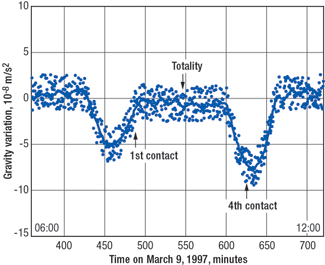What's new in exploration
A more effective Allais Effect. The last time I wrote about the Allais Effect was in this column, September 1999. The occasion was NASA’s idea to coordinate a global investigation of the oddity, to coincide with the 1999 trans-Europe solar eclipse. Thus far, that effort settled nothing. For the few uninitiated, the Allais Effect refers to a weird motion on a Foucault pendulum. Maurice Allais recorded an anomalous pendulum motion of about 13° during a partial eclipse over Paris in 1954. He repeated the experiment in 1959. Most folks have seen such pendulums swinging in a tall atrium, often in a museum. Such pendulums prove that the Earth is rotating on its axis. Envision one at the North Pole, swinging back and forth on a well-lubricated bearing, while the Earth turns a full circle beneath it every 24 hours, and you get the idea. Tom Van Flandern’s latest work, this time with X.S. Yang, is mistitled, “Allais gravity and pendulum effects during solar eclipses explained.” The authors question proposed causes for the Effect. They first point out that the “hypothesis” relies on the unknown properties of gravity. Over the years, many researchers have proposed ideas, such as gravitational shielding and/or focusing. If such shielding does exist, it could be due to a partial blocking of gravitational particles – assuming such particles exist. Another mechanism might be blocking of gravitational waves from the sun by the moon. But if the sun’s gravity is blocked, then shouldn’t the result be an increase in the Earth-pointing component of gravity? Research has not shown this to be the case. However, you could just as easily speculate that an increase in sun-moon gravity for some reason (Who knows? – gravity focusing?) would oppose, that is, decrease, the pull of Earth. A reasonably well-made series of measurements, taken during the 1997 total eclipse in China, showed a decrease in gravity at the beginning and end of the eclipse (see figure). The amount of decrease was about 0.7 millionths of a percent of the normal gravity value. Another idea is based on the fact that an eclipse produces a cone of shadow through the atmosphere, moving at least 1,600 to 3,200 ft per sec. This, in turn, might create changes in temperature, wind and barometric pressure. Flandern showed that it was possible to get a gravitational response similar in shape to the graph on this page with mathematical modeling. Unfortunately, the modeling was not based on atmospheric measurements; rather, on logical assumptions and similar reasoning designed to fit the graph. While there is evidence of a change in barometric pressure during the 1999 European eclipse (Georgatos, 1999), it is suspect as to whether it is truly associated with the eclipse, since it was measured over 400 miles from the eclipse path.
The same mathematics also show that, even with favorable assumptions (for an explanation), the effect of the moving shadow in air is still 100,000 times too small to explain the retrograde motion of a pendulum, such as that measured by Allais, which is why I said “mistitled.” Thus far, nothing fully explains observations made to date. In my view, it remains very possible that the Allais Effect – if it exists at all – has nothing to do with gravity. Even if it does, it might well be a property of gravity that is unimagined. It is certainly worthy of further investigation. Because the Effect is so inconsistent, because Foucault pendulums are rarely in the path of totality, and because, when gravity measurements are involved, anomalies are often just above background noise, there will always be the specter of systematic error. To eliminate this difficulty, gravity measurements and pendulums – to the extent possible – must be shielded from temperature, wind and barometric changes. Whatever is used, they must be in pairs, separated by some distance. If two instruments, properly isolated, record the same anomaly, systematic error becomes unlikely. I’d like to see a couple of 90-ft Foucault pendulums built. These could be set up inside grain silos, which can easily be built from interlocking cement blocks, placed in the path of an eclipse. Various torsion pendulums, gravity meters and weather instruments would be used in connection with the experiment. The practical payoff of this is unknowable, but tiny anomalies can portend great discoveries. There are many examples of this, but what comes to mind is the once heretical idea that mass is not constant, proffered by a fellow named Einstein. He said that mass would grow with speed, but the difference was extremely tiny unless the speed was a significant fraction of the speed of light. From this idea quickly derives the famous E = mc2, that is, energy equals mass. We spend hundreds of millions of dollars on science that is far more esoteric: comet dust, solar wind particles, greater resolution on the cosmic background radiation, and much more. Surely, a mere million dollars could be spent on this mystery, considering the potential for breakthrough discovery in the fundamental laws of the universe.
|
|||||||||||





